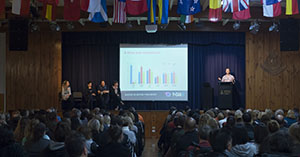Some studies say two out of three young people between the ages of 16 and 18 have sexted.
Whatever the precise figures, sexting is very prevalent at an important time in a young person’s development when they are expressing their sexuality – and they are utilising technology to do that.
Sexting is part of being a young person. We are in the iPhone era. A young person has an iPhone or smartphone with them much of the time and it has become part of how they are developing their sexual identity.
We’ve done it through generations with art, the press and by writing risqué things. Every time we have a new technology coming in to the sexual space we get worried.
I think parents are scared about sexting because the internet feels permanent. But young people are aware of the internet and its ramifications. They’ve grown up with it and they know how images are stored.
A parent sees that a young person’s picture could be taken from a phone and put somewhere else, but young people understand there are billions of images flooding the internet, and that makes their image only one of billions.
But we need to make a clear distinction between sexting – two consenting people expressing themselves to each other in a sexual manner – and revenge porn, where someone takes an image or video they’ve received and passes it on or posts it without a person’s consent. That is very, very different.

But the law has not caught up with technology.
Under federal law, if you are under 18 and you take a picture and send it, or if you are under 18 and receive a picture, it’s a criminal act and can be prosecuted under the Child Pornography Distribution Act. We have many cases of young people who sext consensually and end up on the sex offenders list along with serial paedophiles.
If sexting is with consent, it shouldn’t come under that criminal act. It is very important to have laws to protect children but we don’t want to see young people with a criminal history for expressing themselves while working out their sexual identity.
Have a conversation about sexting in the same way you’d have a conversation about sex. Talk about what they feel comfortable with around sexting.
Has anybody asked you to send images? Did you send them? Where did that picture go and to whom? How did it make you feel? Did you feel pressured?
If someone is asking you for an intimate picture you need to make an informed decision about whether to send it or not. Do you trust that person? And talk about how things can change. Someone may say they love you and that picture is just for us – but if you send a picture, you don’t really know what will happen to it.
Ignoring the fact that many young people are sexting won’t make the issue go away. If they are going to do it, they can manage the negative effects of someone passing it on by having no identifying elements. So don’t put your face in the image or don’t show a birthmark that is obviously you and then your child can deny it is them if their picture is passed on.
If you talk about sexting and start from a place of ‘I can’t believe you’ve done this’ … your child won’t tell you how deep this has gone.
It’s part of their healthy sexual development but they may make a mistake and not know how to handle it. As a parent, you can help them through that.
Katie Acheson is CEO of Youth Action, a peak organisation representing young people and youth services. www.youthaction.org.au




